Abstract
A total of 18 strains of Mycobacterium fortuitum, 15 strains of M. chelonei, and 31 strains of M. chelonei-like organisms were tested by both broth microdilution and agar dilution to determine their susceptibility to 34 antimicrobial agents. All strains grew well enough in cation-supplemented Mueller-Hinton broth for endpoints to be read after 72 h of incubation. Some strains of M. chelonei did not grow on Mueller-Hinton agar. A few discrepancies were noted between the broth and agar procedures. For M. fortuitum, doxycycline, minocycline, amikacin, sulfamethoxazole, and sulfamethoxazole-trimethoprim were the most active agents. For M. chelonei, amikacin, sisomicin, tobramycin, and erythromycin were the most active agents. The M. chelonei-like organisms were most susceptible to ampicillin, doxycycline, minocycline, amikacin, erythromycin, sulfamethoxazole, and sulfamethoxazole-trimethoprim. Broth microdilution appears to be a reliable method for susceptibility testing of rapidly growing mycobacteria, although clinical studies are needed to determine how well in vitro results correlate with therapeutic in vivo outcome.
Full text
PDF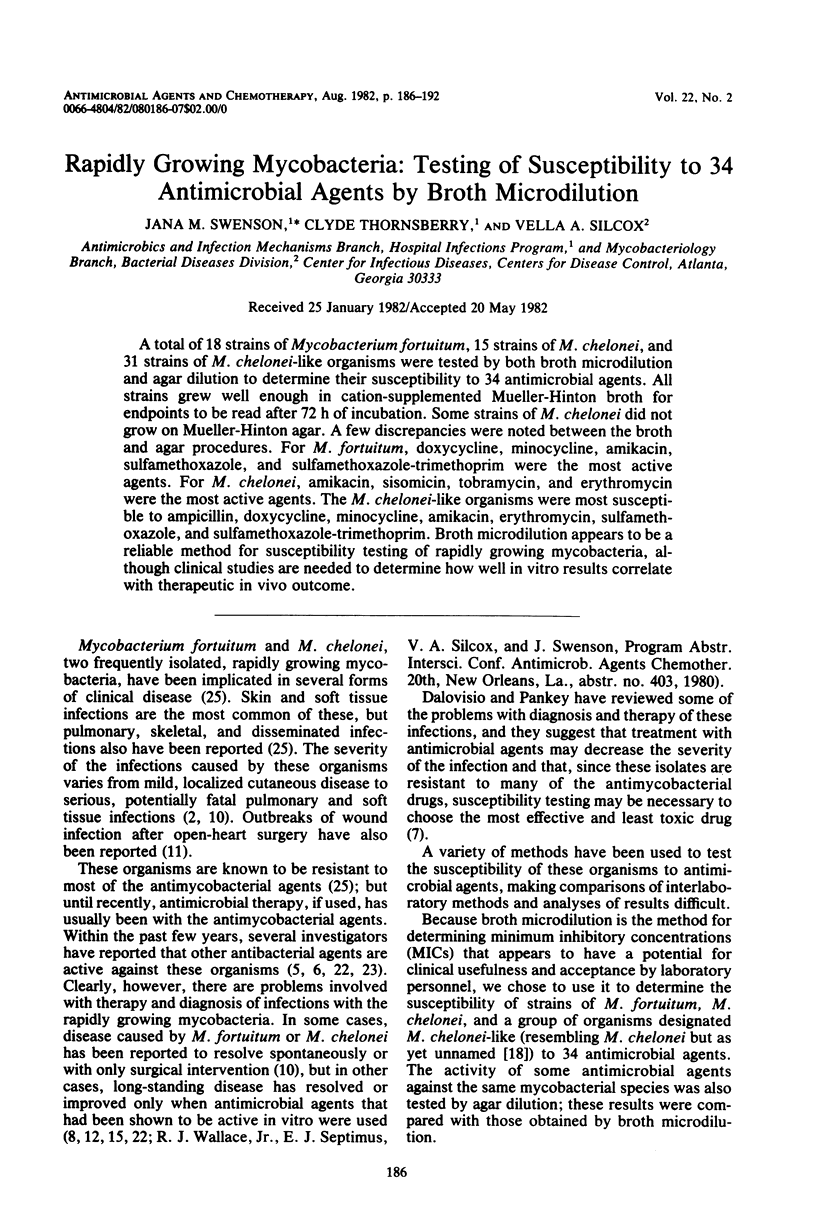
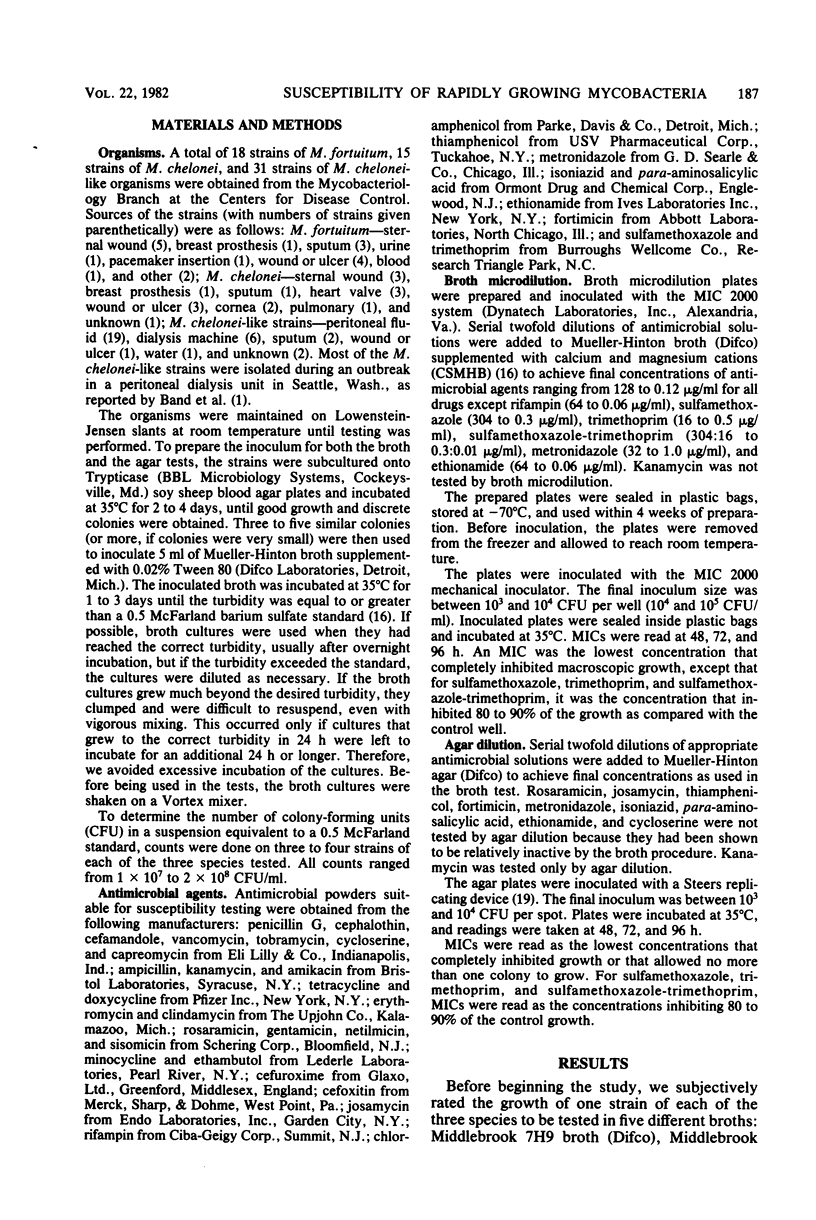
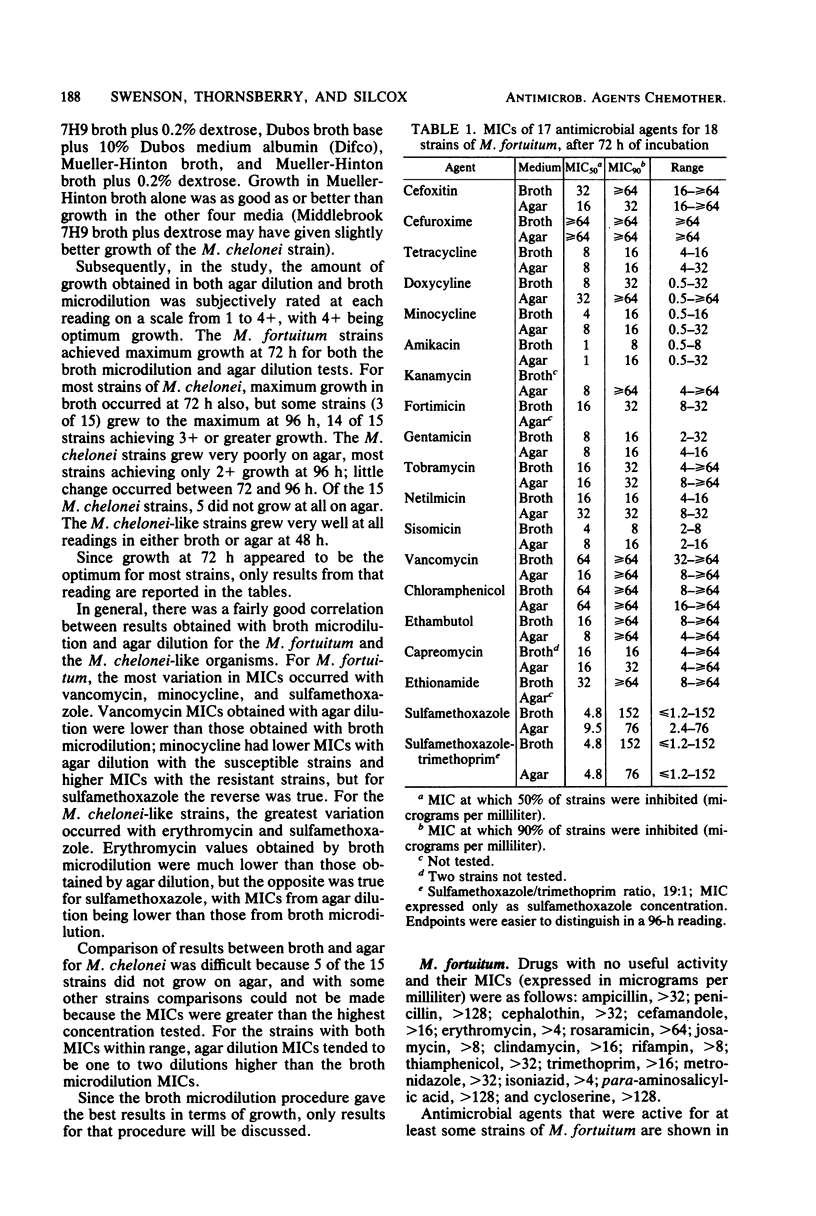
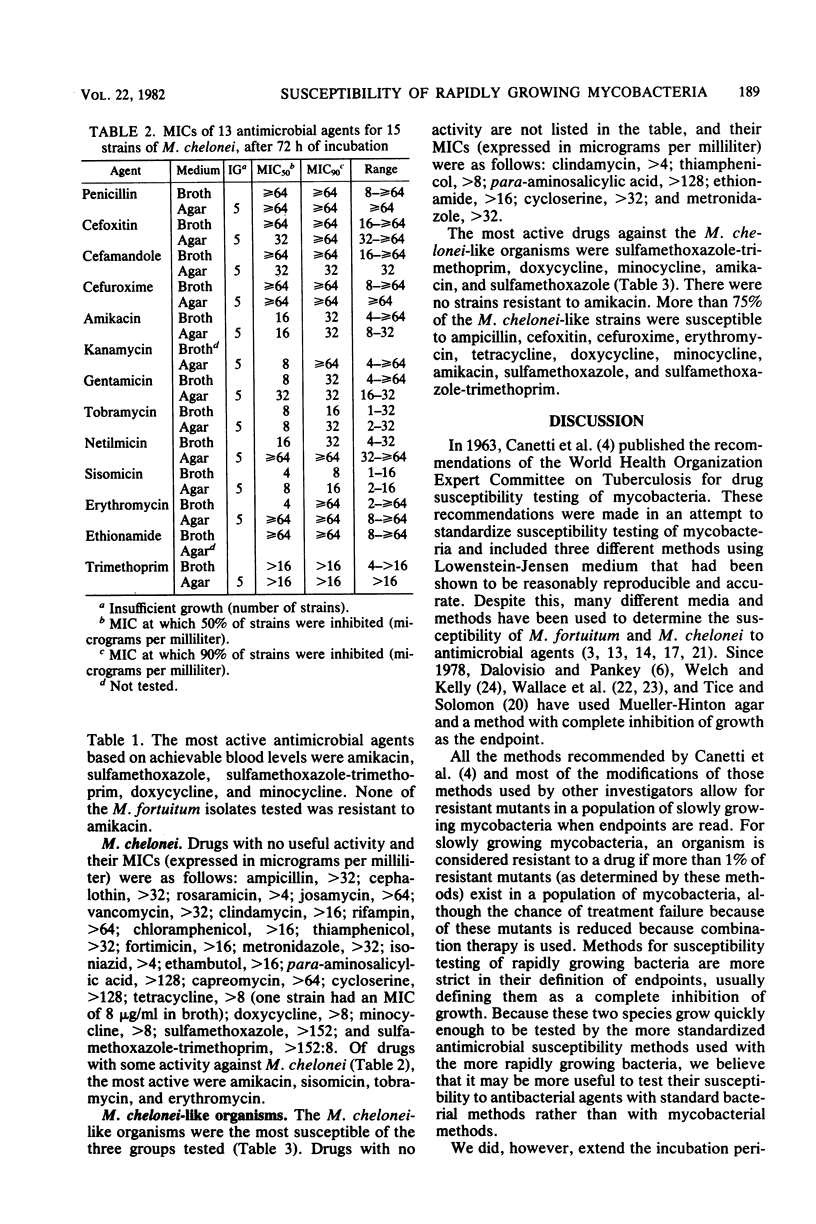
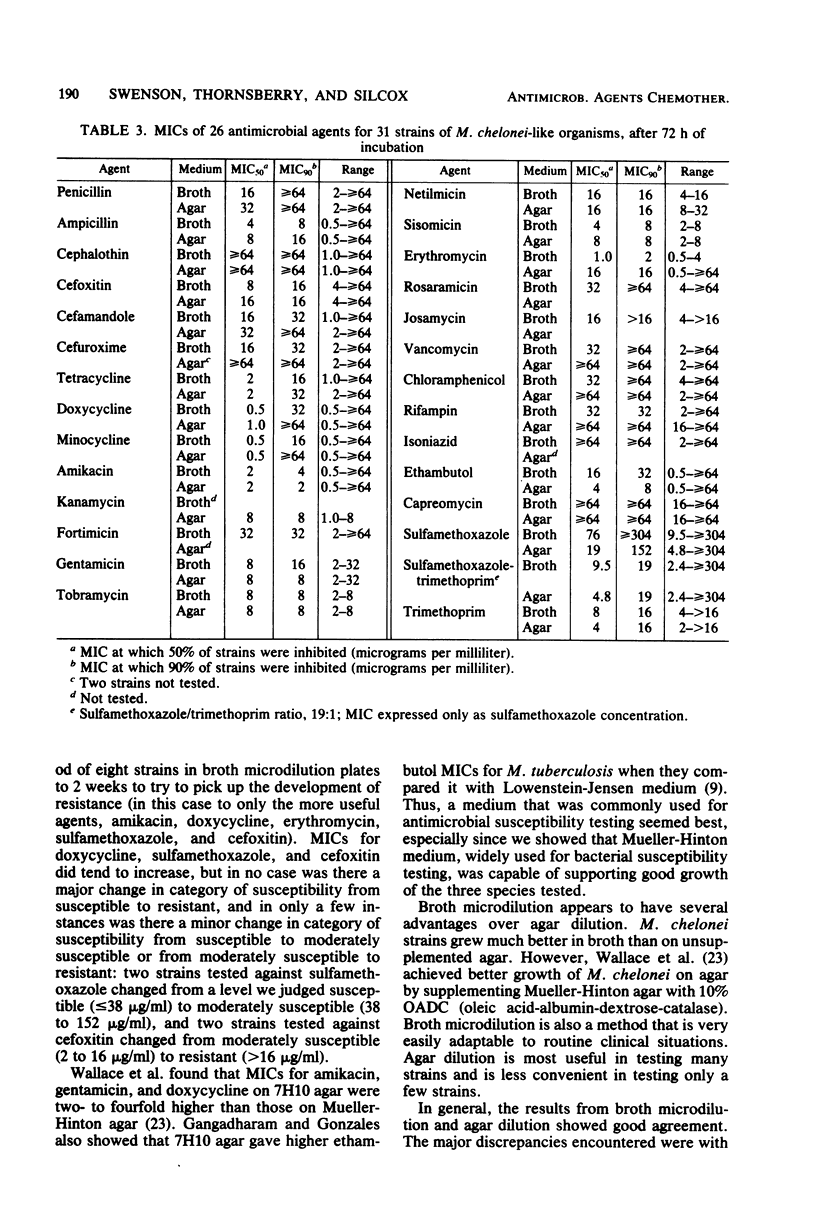
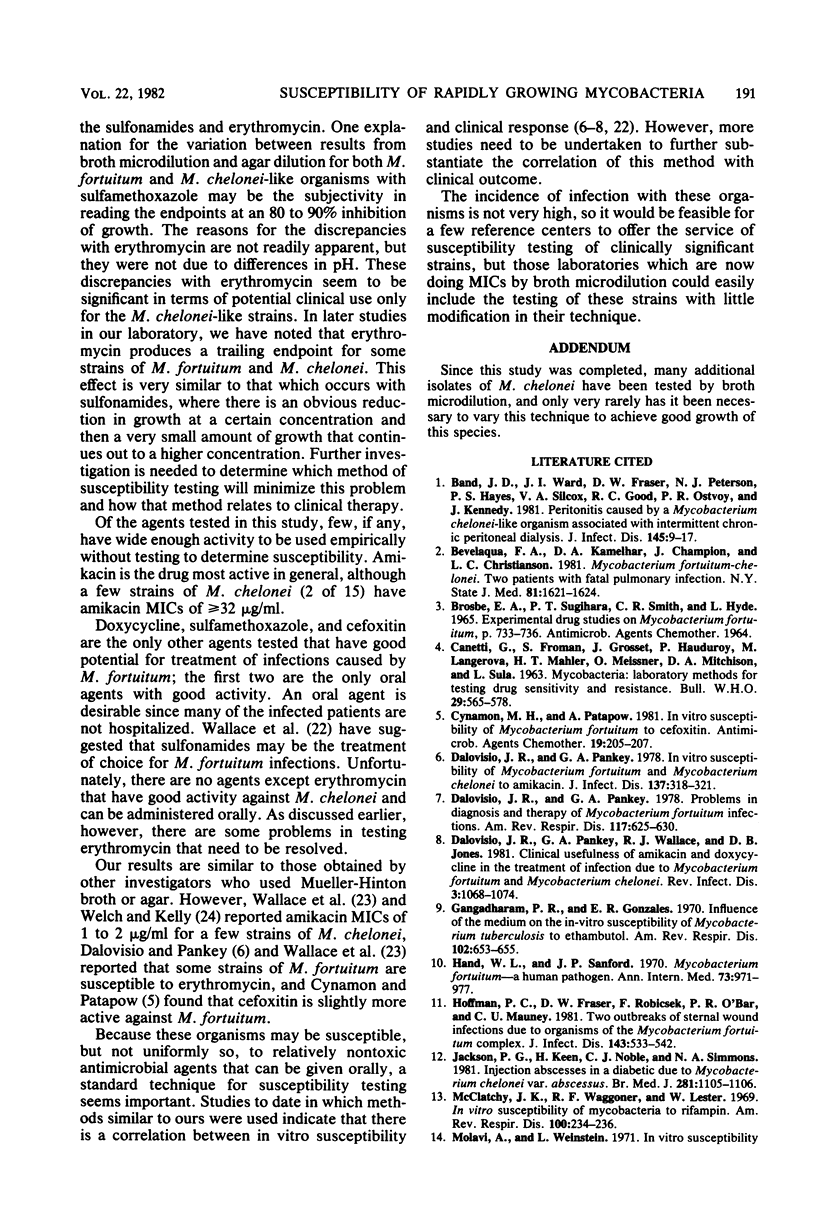
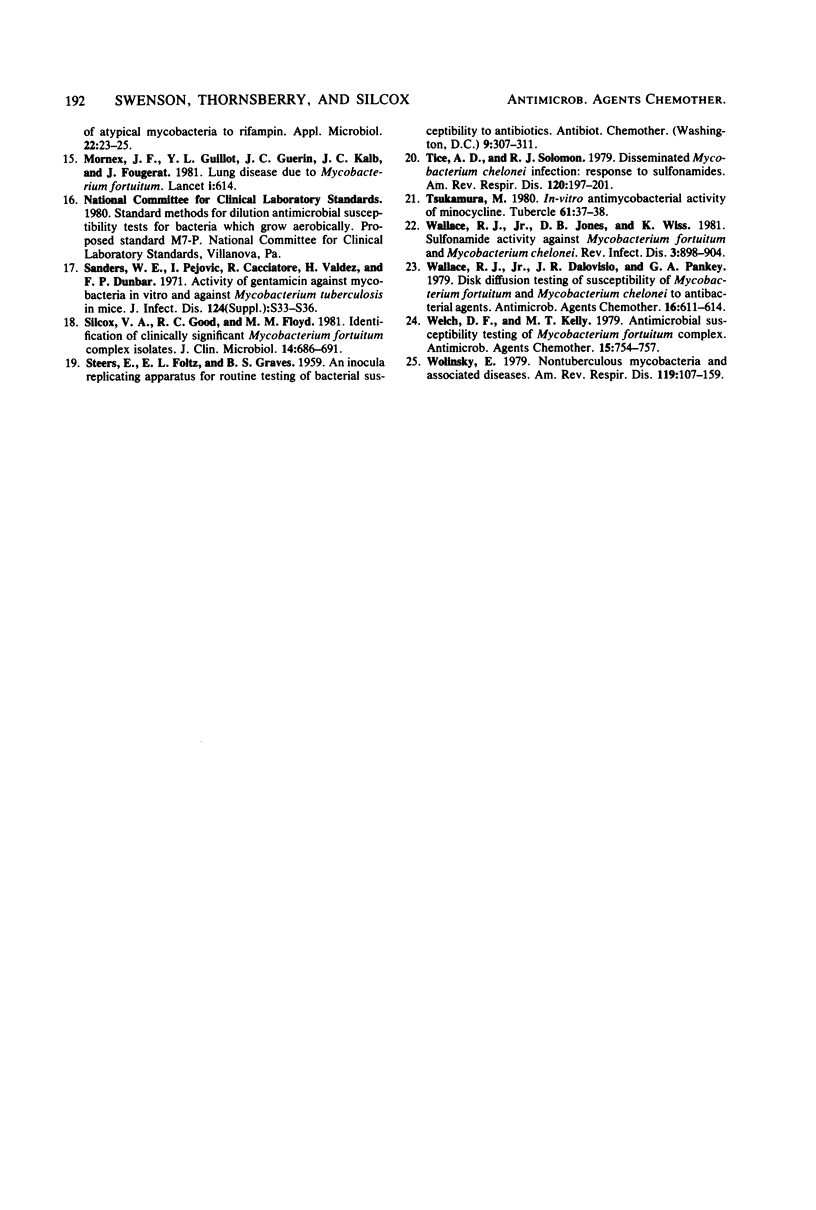
Selected References
These references are in PubMed. This may not be the complete list of references from this article.
- Band J. D., Ward J. I., Fraser D. W., Peterson N. J., Silcox V. A., Good R. C., Ostroy P. R., Kennedy J. Peritonitis due to a mycobacterium chelonei-like organism associated with intermittent chronic peritoneal dialysis. J Infect Dis. 1982 Jan;145(1):9–17. doi: 10.1093/infdis/145.1.9. [DOI] [PubMed] [Google Scholar]
- Bevelaqua F. A., Kamelhar D. A., Campion J., Christianson L. C. Mycobacterium fortuitum-chelonei; two patients with fatal pulmonary infection. N Y State J Med. 1981 Oct;81(11):1621–1624. [PubMed] [Google Scholar]
- CANETTI G., FROMAN S., GROSSET J., HAUDUROY P., LANGEROVA M., MAHLER H. T., MEISSNER G., MITCHISON D. A., SULA L. MYCOBACTERIA: LABORATORY METHODS FOR TESTING DRUG SENSITIVITY AND RESISTANCE. Bull World Health Organ. 1963;29:565–578. [PMC free article] [PubMed] [Google Scholar]
- Cynamon M. H., Patapow A. In vitro susceptibility of Mycobacterium fortuitum to cefoxitin. Antimicrob Agents Chemother. 1981 Jan;19(1):205–207. doi: 10.1128/aac.19.1.205. [DOI] [PMC free article] [PubMed] [Google Scholar]
- Dalovisio J. R., Pankey G. A. In vitro susceptiiblity of Mycobacterium fortuitum and Mycobacterium chelonei to amikacin. J Infect Dis. 1978 Mar;137(3):318–321. doi: 10.1093/infdis/137.3.318. [DOI] [PubMed] [Google Scholar]
- Dalovisio J. R., Pankey G. A. Problems in diagnosis and therapy of Mycobacterium fortuitum infections. Am Rev Respir Dis. 1978 Apr;117(4):625–630. doi: 10.1164/arrd.1978.117.4.625. [DOI] [PubMed] [Google Scholar]
- Dalovisio J. R., Pankey G. A., Wallace R. J., Jones D. B. Clinical usefulness of amikacin and doxycycline in the treatment of infection due to Mycobacterium fortuitum and Mycobacterium chelonei. Rev Infect Dis. 1981 Sep-Oct;3(5):1068–1074. doi: 10.1093/clinids/3.5.1068. [DOI] [PubMed] [Google Scholar]
- Gangadharam P. R., Gonzales E. R. Influence of the medium on the in vitro susceptibility of Mycobacterium tuberculosis to ethambutol. Am Rev Respir Dis. 1970 Oct;102(4):653–655. doi: 10.1164/arrd.1970.102.4.653. [DOI] [PubMed] [Google Scholar]
- Hand W. L., Sanford J. P. Mycobacterium fortuitum--a human pathogen. Ann Intern Med. 1970 Dec;73(6):971–977. doi: 10.7326/0003-4819-73-6-971. [DOI] [PubMed] [Google Scholar]
- Hoffman P. C., Fraser D. W., Robicsek F., O'Bar P. R., Mauney C. U. Two outbreaks of sternal wound infection due to organisms of the Mycobacterium fortuitum complex. J Infect Dis. 1981 Apr;143(4):533–542. doi: 10.1093/infdis/143.4.533. [DOI] [PubMed] [Google Scholar]
- Jackson P. G., Keen H., Noble C. J., Simmons N. A. Injection abscesses in a diabetic due to Mycobacterium chelonei var abscessus. Br Med J. 1980 Oct 25;281(6248):1105–1106. doi: 10.1136/bmj.281.6248.1105. [DOI] [PMC free article] [PubMed] [Google Scholar]
- McClatchy J. K., Waggoner R. F., Lester W. In vitro susceptibility of mycobacteria to rifampin. Am Rev Respir Dis. 1969 Aug;100(2):234–236. doi: 10.1164/arrd.1969.100.2.234. [DOI] [PubMed] [Google Scholar]
- Mornex J. F., Guillot Y. L., Guerin J. C., Kalb J. C., Fougerat J. Lung disease due to Mycobacterium fortuitum. Lancet. 1981 Mar 14;1(8220 Pt 1):614–614. doi: 10.1016/s0140-6736(81)92061-4. [DOI] [PubMed] [Google Scholar]
- Sanders W. E., Cacciatore R., Valdez H., Pejovic I., Dunbar F. P. Activity of gentamicin against mycobacteria in vitro and against Mycobacterium tuberculosis in mice. J Infect Dis. 1971 Dec;124 (Suppl):S33–S36. doi: 10.1093/infdis/124.supplement_1.s33. [DOI] [PubMed] [Google Scholar]
- Silcox V. A., Good R. C., Floyd M. M. Identification of clinically significant Mycobacterium fortuitum complex isolates. J Clin Microbiol. 1981 Dec;14(6):686–691. doi: 10.1128/jcm.14.6.686-691.1981. [DOI] [PMC free article] [PubMed] [Google Scholar]
- Tice A. D., Solomon R. J. Disseminated Mycobacterium chelonei infection: response to sulfonamides. Am Rev Respir Dis. 1979 Jul;120(1):197–201. doi: 10.1164/arrd.1979.120.1.197. [DOI] [PubMed] [Google Scholar]
- Tsukamura M. In-vitro antimycobacterial activity of minocycline. Tubercle. 1980 Mar;61(1):37–38. doi: 10.1016/0041-3879(80)90058-6. [DOI] [PubMed] [Google Scholar]
- Wallace R. J., Jr, Dalovisio J. R., Pankey G. A. Disk diffusion testing of susceptibility of Mycobacterium fortuitum and Mycobacterium chelonei to antibacterial agents. Antimicrob Agents Chemother. 1979 Nov;16(5):611–614. doi: 10.1128/aac.16.5.611. [DOI] [PMC free article] [PubMed] [Google Scholar]
- Wallace R. J., Jr, Jones D. B., Wiss K. Sulfonamide activity against Mycobacterium fortuitum and Mycobacterium chelonei. Rev Infect Dis. 1981 Sep-Oct;3(5):898–904. doi: 10.1093/clinids/3.5.898. [DOI] [PubMed] [Google Scholar]
- Welch D. F., Kelly M. T. Antimicrobial susceptibility testing of Mycobacterium fortuitum complex. Antimicrob Agents Chemother. 1979 Jun;15(6):754–757. doi: 10.1128/aac.15.6.754. [DOI] [PMC free article] [PubMed] [Google Scholar]
- Wolinsky E. Nontuberculous mycobacteria and associated diseases. Am Rev Respir Dis. 1979 Jan;119(1):107–159. doi: 10.1164/arrd.1979.119.1.107. [DOI] [PubMed] [Google Scholar]


